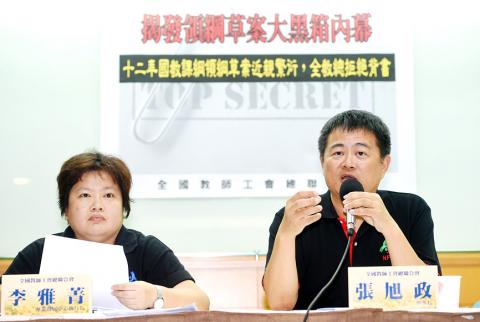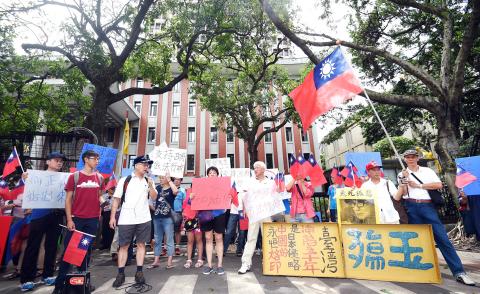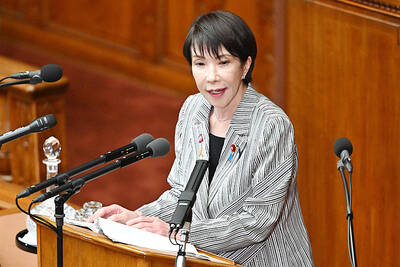The approval process for a new 12-year education plan continues to use the same opaque procedures behind earlier controversial adjustments to high-school curriculum guidelines, a teachers’ union alleged yesterday, calling for the process to be “rebooted.”
“The ‘fine-tuning’ of history curriculum guidelines was already unacceptable, but we care even more about the process under which new guidelines for all subjects are to be produced,” National Federation of Teachers’ Unions president Chang Hsu-cheng (張旭政) told a news conference in Taipei. “While in the past the Ministry of Education has tightly controlled the drafting of guidelines, we feel the process should be opened up to allow for a more diverse range of opinions to be represented.”
Chang said that all appointments to new guideline drafting committees were made by committee conveners directly appointed by Ko Hwa-wei (柯華葳), president of the National Academy for Educational Research, the agency that oversees the creation of curriculum guidelines, adding that a reliance on personal relationships had resulted in “like-minded” committee members making decisions that did not reflect the public’s point of view.

Photo: Lo Pei-der, Taipei Times
Following the so-called “minor adjustments” of social studies curriculum guidelines last year, the academy is currently in the process of drafting new guidelines as part of plans to implement a compulsory 12-year education plan. The ministry’s plan calls for sweeping changes to curriculum guidelines beginning in 2018, including a sharp reduction to the number of required classes to make room for a range of new electives.
Li Ya-jing (李雅菁), chief of the federation’s professional development center, said the academy rejected the vast majority of teachers nominated by the union, with none of their elementary-school and middle-school teacher nominees appointed.
While the academy invited the union to nominate representatives for “consultative forums,” membership was still subject to approval by the drafting committee conveners and any forum conclusions would merely be sent to the committees for “consideration” rather than having any kind of binding force, Li said.

Photo: Lo Pei-der, Taipei Times
She called for implementation of new guidelines to be delayed to allow for a “reboot” of the process, including a reshuffling of the drafting committees’ membership to allow for more substantial federation representation.
Guideline drafts proposed by the academy’s committees were rejected earlier this month by the ministry’s curriculum development team for unspecified reasons.
Chang, a member of the team, said he did not know why the guidelines were rejected as he was abroad at the time, adding that the power of the team was limited, because it could only veto guidelines rather than directly call for changes.
Chang said the federation would turn down all invitations sent by the academy requesting their members’ presence at public hearings on the curriculum guidelines, which are scheduled to take place next month and in October, because the academy’s actions are an attempt to mislead the public into believing that the guidelines were introduced after effective communication.
The academy rejected the allegation, saying four teachers recommended by the federation were on the curriculum guideline development and revision teams.
It also dismissed accusations that members of the development teams were chosen by an “old boys’ network,” saying the members were vetted from a pool of academics and experts twice as large as its current staff, in compliance with due legal process.
Regarding the alleged rigging of the guidelines approval process, the academy said the guidelines are the result of collaboration among more than 700 certified teachers who invested considerable amounts of time and energy to gather information, draft, debate and discuss their work, adding that counseling and review committees have been put into place, while online forums and public hearings have also been arranged.
On the allegation that it has not made public the roster of development team members, the academy said that was a “clear misunderstanding,” as the list, as well as session minutes, are readily available on its Web site.

The Central Weather Administration (CWA) yesterday said it expected to issue a sea warning for Typhoon Fung-Wong tomorrow, which it said would possibly make landfall near central Taiwan. As of 2am yesterday, Fung-Wong was about 1,760km southeast of Oluanpi (鵝鑾鼻), Taiwan’s southernmost point, moving west-northwest at 26kph. It is forecast to reach Luzon in the northern Philippines by tomorrow, the CWA said. After entering the South China Sea, Typhoon Fung-Wong is likely to turn northward toward Taiwan, CWA forecaster Chang Chun-yao (張峻堯) said, adding that it would likely make landfall near central Taiwan. The CWA expects to issue a land

Taiwan’s exports soared to an all-time high of US$61.8 billion last month, surging 49.7 percent from a year earlier, as the global frenzy for artificial intelligence (AI) applications and new consumer electronics powered shipments of high-tech goods, the Ministry of Finance said yesterday. It was the first time exports had exceeded the US$60 billion mark, fueled by the global boom in AI development that has significantly boosted Taiwanese companies across the international supply chain, Department of Statistics Director-General Beatrice Tsai (蔡美娜) told a media briefing. “There is a consensus among major AI players that the upcycle is still in its early stage,”

The Central Weather Administration (CWA) yesterday said it is expected to issue a sea warning for Typhoon Fung-wong this afternoon and a land warning tomorrow. As of 1pm, the storm was about 1,070km southeast of Oluanpi (鵝鑾鼻), Taiwan’s southernmost point, and was moving west-northwest at 28 to 32kph, according to CWA data. The storm had a radius of 250km, with maximum sustained winds of 173kph and gusts reaching 209kph, the CWA added. The storm is forecast to pass near Luzon in the Philippines before entering the South China Sea and potentially turning northward toward Taiwan, the CWA said. CWA forecaster Chang Chun-yao (張峻堯) said

Japanese Prime Minister Sanae Takaichi yesterday said that China using armed force against Taiwan could constitute a "survival-threatening situation" for Japan, allowing the country to mobilize the Japanese armed forces under its security laws. Takaichi made the remarks during a parliamentary session while responding to a question about whether a "Taiwan contingency" involving a Chinese naval blockade would qualify as a "survival-threatening situation" for Japan, according to a report by Japan’s Asahi Shimbun. "If warships are used and other armed actions are involved, I believe this could constitute a survival-threatening situation," Takaichi was quoted as saying in the report. Under Japan’s security legislation,